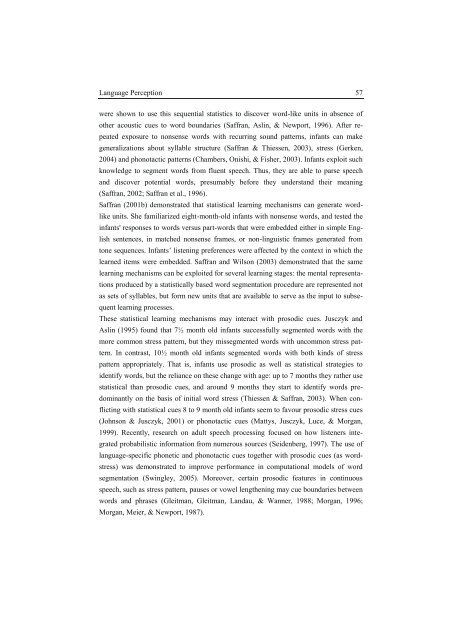Neural Correlates of Processing Syntax in Music and ... - PubMan
Neural Correlates of Processing Syntax in Music and ... - PubMan
Neural Correlates of Processing Syntax in Music and ... - PubMan
Create successful ePaper yourself
Turn your PDF publications into a flip-book with our unique Google optimized e-Paper software.
Language Perception 57<br />
were shown to use this sequential statistics to discover word-like units <strong>in</strong> absence <strong>of</strong><br />
other acoustic cues to word boundaries (Saffran, Asl<strong>in</strong>, & Newport, 1996). After repeated<br />
exposure to nonsense words with recurr<strong>in</strong>g sound patterns, <strong>in</strong>fants can make<br />
generalizations about syllable structure (Saffran & Thiessen, 2003), stress (Gerken,<br />
2004) <strong>and</strong> phonotactic patterns (Chambers, Onishi, & Fisher, 2003). Infants exploit such<br />
knowledge to segment words from fluent speech. Thus, they are able to parse speech<br />
<strong>and</strong> discover potential words, presumably before they underst<strong>and</strong> their mean<strong>in</strong>g<br />
(Saffran, 2002; Saffran et al., 1996).<br />
Saffran (2001b) demonstrated that statistical learn<strong>in</strong>g mechanisms can generate wordlike<br />
units. She familiarized eight-month-old <strong>in</strong>fants with nonsense words, <strong>and</strong> tested the<br />
<strong>in</strong>fants' responses to words versus part-words that were embedded either <strong>in</strong> simple English<br />
sentences, <strong>in</strong> matched nonsense frames, or non-l<strong>in</strong>guistic frames generated from<br />
tone sequences. Infants’ listen<strong>in</strong>g preferences were affected by the context <strong>in</strong> which the<br />
learned items were embedded. Saffran <strong>and</strong> Wilson (2003) demonstrated that the same<br />
learn<strong>in</strong>g mechanisms can be exploited for several learn<strong>in</strong>g stages: the mental representations<br />
produced by a statistically based word segmentation procedure are represented not<br />
as sets <strong>of</strong> syllables, but form new units that are available to serve as the <strong>in</strong>put to subsequent<br />
learn<strong>in</strong>g processes.<br />
These statistical learn<strong>in</strong>g mechanisms may <strong>in</strong>teract with prosodic cues. Jusczyk <strong>and</strong><br />
Asl<strong>in</strong> (1995) found that 7½ month old <strong>in</strong>fants successfully segmented words with the<br />
more common stress pattern, but they missegmented words with uncommon stress pattern.<br />
In contrast, 10½ month old <strong>in</strong>fants segmented words with both k<strong>in</strong>ds <strong>of</strong> stress<br />
pattern appropriately. That is, <strong>in</strong>fants use prosodic as well as statistical strategies to<br />
identify words, but the reliance on these change with age: up to 7 months they rather use<br />
statistical than prosodic cues, <strong>and</strong> around 9 months they start to identify words predom<strong>in</strong>antly<br />
on the basis <strong>of</strong> <strong>in</strong>itial word stress (Thiessen & Saffran, 2003). When conflict<strong>in</strong>g<br />
with statistical cues 8 to 9 month old <strong>in</strong>fants seem to favour prosodic stress cues<br />
(Johnson & Jusczyk, 2001) or phonotactic cues (Mattys, Jusczyk, Luce, & Morgan,<br />
1999). Recently, research on adult speech process<strong>in</strong>g focused on how listeners <strong>in</strong>tegrated<br />
probabilistic <strong>in</strong>formation from numerous sources (Seidenberg, 1997). The use <strong>of</strong><br />
language-specific phonetic <strong>and</strong> phonotactic cues together with prosodic cues (as wordstress)<br />
was demonstrated to improve performance <strong>in</strong> computational models <strong>of</strong> word<br />
segmentation (Sw<strong>in</strong>gley, 2005). Moreover, certa<strong>in</strong> prosodic features <strong>in</strong> cont<strong>in</strong>uous<br />
speech, such as stress pattern, pauses or vowel lengthen<strong>in</strong>g may cue boundaries between<br />
words <strong>and</strong> phrases (Gleitman, Gleitman, L<strong>and</strong>au, & Wanner, 1988; Morgan, 1996;<br />
Morgan, Meier, & Newport, 1987).












